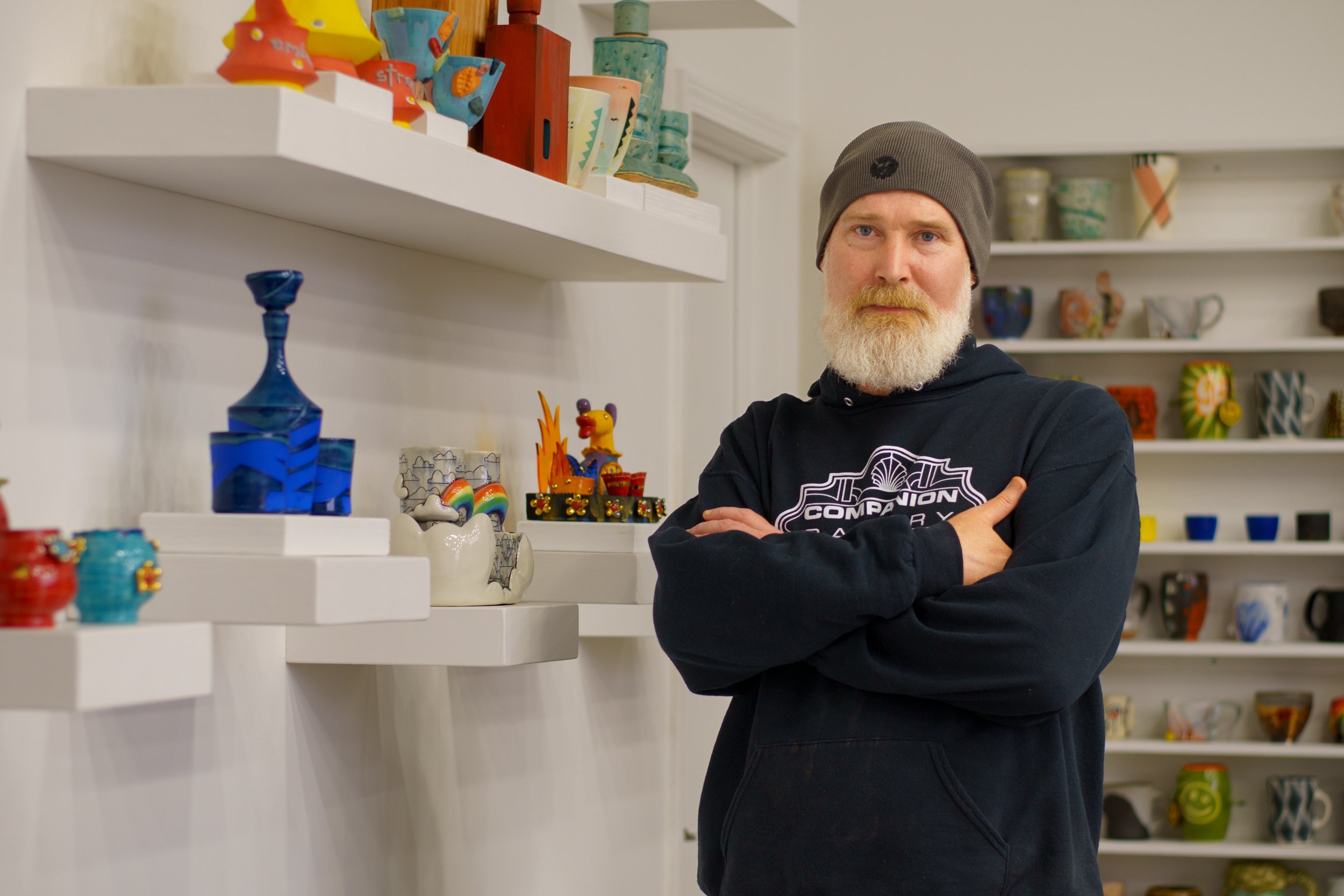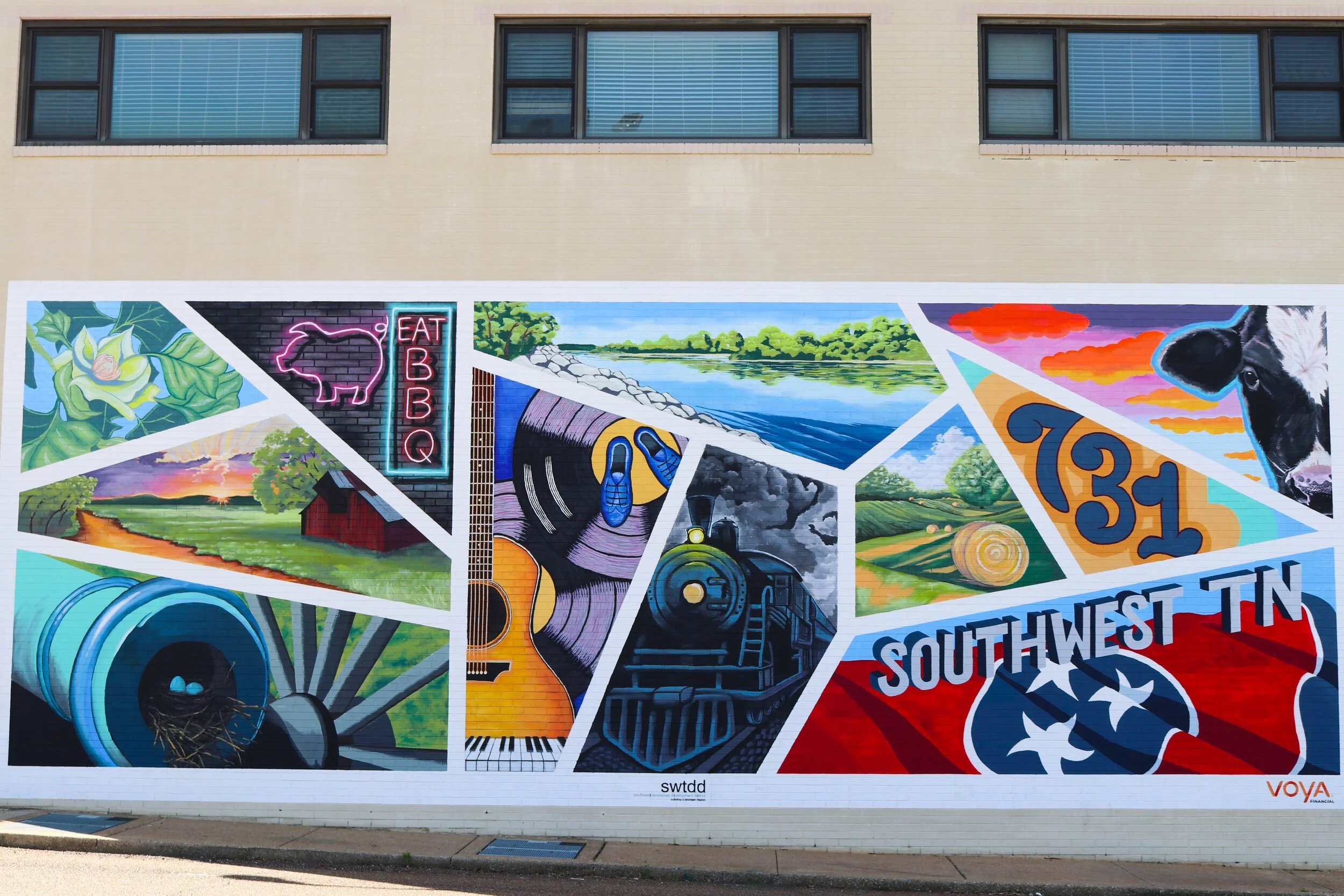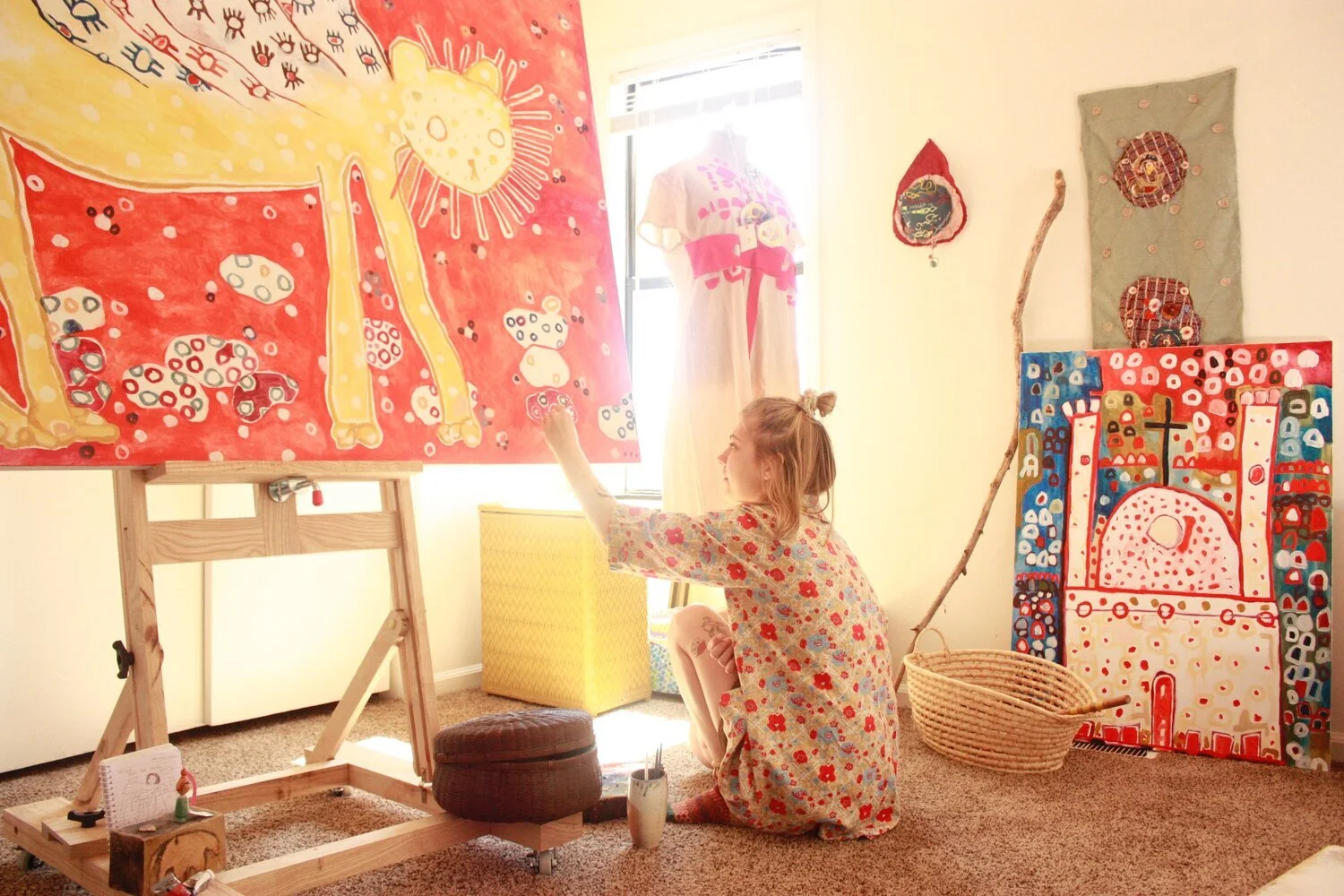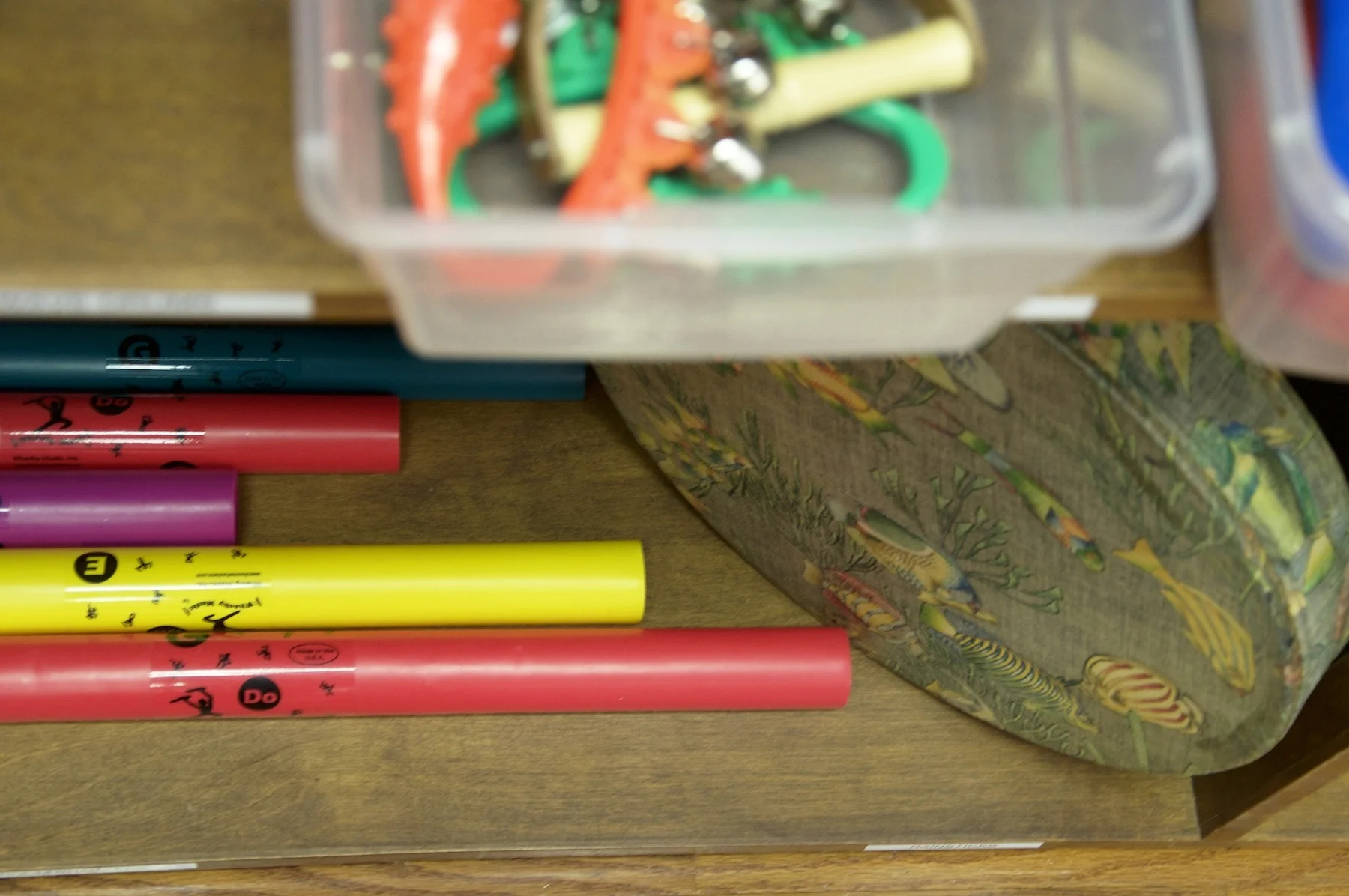The Potter's House
This piece was originally published in the Summer 2016 issue of Our Jackson Home: The Magazine.
On the hillside of a Humboldt vineyard, in what was once a barn in the land’s historic farm days, is the Companion Gallery, where local ceramicist Eric Botbyl has his studio as well as a gallery shop featuring work by fellow potters from around the country. It’s a quiet place where the doors are left open to catch the breeze on spring days like today and is kept warm by a wood-burning stove in the winter. It’s surrounded by twenty-two acres of grapevines and neighbors the Crown Winery’s Tuscan-style villa.
“I try not to ever make the same cup twice,” Eric says, “but I do like to work in a series. For the longest time my work was really symmetrical and was based off of a square cup or something six-sided, and I just realized that working asymmetrically was a kind of deficiency I had. So about a year ago I gave myself kind of a challenge to start working more asymmetrically. . . .” Sitting at his wheel with a perfectly smooth and symmetrical vase, he pinches the neck and bends it a little to give the vase’s opening a quirky, asymmetrical tilt.
This year marks Eric’s twentieth year working in ceramics. He discovered the discipline as a student at Union University and has been at it since. After he graduated, Morris Nursery hired him as a potter and provided him with his first studio, allowing him to grow in his craft and to begin teaching lessons. Today you’ll find him at the Companion Gallery, which opened in 2008, where you can take classes, browse the shop, and discover new potters through his curated shows.
“Where do you find inspiration for your work?” I ask.
“That’s a tricky question,” he tells me. “I’m not trying to create imagery. It’s not like I’m inspired by this sunset, and I’m going to make a glaze like a sunset. . . I have things that catch my eye, and then I think I just tuck them away in the back of my mind and just work all the time. It seems like paying attention to your own life and working all the time, those things just come out.
“For instance, years ago when Jill was pregnant with our oldest daughter, I’d go to the studio all day and work, then I’d come home, and we’d sit together there on the couch and watch TV at night or something, and I’d just have my hand resting on her belly. And sitting there like that over the course of a couple of hours, you can feel those knees or elbows rolling across the surface of her belly. And it’s just an amazing experience, you know? My favorite person, and here’s this tiny person growing that we’ve made. I cherished those moments, but I never really meant to make pots about that. So weeks or months go by, I would come home and Jill would say, ‘What did you make today? What are you working on at the studio?’ And I’d say, ‘Well, I’m making these really wide-shouldered jars and am reaching in there and am bumping out these lobes up around the rim.’ And she said, ‘You know, that sounds like me.’ So I go back to the studio the next day and pull back the plastic and it is. It’s all these fat, pregnant-looking jars with the little knees and elbows, except those marks are preserved. . . .”
Eric’s work, which ranges from mugs to pitchers to baskets and bowls, exudes a sort of organic quality. He utilizes a range of earth tones, sometimes using cool, stony colors or making wide, sea-colored bowls that remind me of stirring tide pools or mugs whose clay nature is so evident in their rich browns and reds that you just know you’re holding something that came from the earth.
“I had another series of work that I would take a thick slab of clay, and I had an old fork, and I would draw these swirling designs across the clay, maybe a quarter-inch deep, and then stretch that clay out. They might start ten by ten, but they’d end up twenty by twenty, so everything changes and distorts, and the finished effect of the platters looked like crop lines. Just rural West Tennessee, like you’re driving past any field. We had recently moved out to Gibson, but the [former] studio was still in Jackson, so I had this thirty-five minute drive every day passing a lot of landscape that I wasn’t driving by before. I don’t know if it’s as much inspiration as it is paying attention. I didn’t really try to do those things, they just happened. Clay is funny that way, how it comes out. And it might take years, and then it will hit me one day, ‘Oh, that’s where that came from.’”
Eric works on a couple of pieces that are in progress as we talk, bringing new form to mugs that have been drying but whose clay is still soft enough to manipulate. His hands work at an unhurried pace, taking as much time with the clay as he seems to take with his words, speaking gently and carefully about his art. He presses outward from inside the mug giving a new, fuller shape to the clay, and carves away at its exterior to give it a wavy texture.
“Texture is something that I’m always drawn to,” he says. “So I make my own stamps.” He shows me square clay blocks that he’s made, having carved intricate grooves and patterns into them so that each imprint connects with itself to make broader panels of texture. He shows me other molds he’s made of zippers and Christmas lights and barbed wire and barn wood that add a more three-dimensional quality to his pieces.
“I do a lot of stamping with barn wood. You know if you look on Pinterest you’ll see a lot of pots with crosses or Bible verses on them. It just seems a little bit trite, you know? . . . I understand it, that folks want to put this expression of their faith on the pots. I just wonder if that’s not the worst way to say it. Having conversations with my professor at Union, he would say it shouldn’t be on the pot, it should be in the pot, in the very core of it. So the barn wood pots came from thinking about that. And I thought, well, clay is almost eternal. It’s always been here. It always will be here. You really can’t destroy it. It’s timeless. And wood, especially this old, crunchy barn wood, it’s temporal. You can just see it; this thing was built, the sun shines on it, the rain rains on, it starts to check and turn gray, and then it starts to rot. And if it makes it 100 years in this world, it’s a long time. So I’ll make these cups and cut out a big section in the front of them and then texture them with the barn wood in different compositions and then graft that back in with a really thick black slip. You know, being here at the vineyard, the idea of grafting, I like that idea. It’s almost like an adoption. You weren’t born here, but you’re going to get to be a part of this thing. So I call them grafted barn wood mugs. So it looks like this old piece of wood that’s been spliced into the face of a coffee mug. I guess that’s how I say it instead of putting a blue shiny cross on the front. That’s what it looks like to me.”
“You talked about the nature of clay and how it’s almost eternal. Do you feel like working with clay has shaped your understanding of the earth?” I ask him.
“I guess this comes to mind: We’re working here at the vineyard, and when I first got here, we discovered that about six feet down all through this vineyard is this beautiful band of white potter’s clay. So we dug about 500 pounds of it and processed it and got it to be workable potter’s clay. And I made a series of wine bottles and wine cups, and then we took wine from the oak barrels inside and filled the bottles with the wine. All the glazes I use are ash glazes that [I make] from wood ash. So that project finished and sitting there on the table was like, ‘Wow.’ We’re going to drink wine from handmade cups that are made of clay that these vines are growing in. And then the glaze is taken from burned trees all along the wood line. It was like vertical integration, the full circle. That was a really tasty glass of wine.”
It’s interesting to watch Eric interacting with clay and pottery as a maker, but I realize as we’re speaking that he has an equally rich experience with ceramics as a user. He takes a coffee mug, made by another potter, that he’s been drinking out of from the shelf and holds it out to show me its narrative. He shows me how he knows it was fired in a wood kiln, the three marks on the side where the piece was fired sitting on top of seashells, the horizontal lines wrapped around the mug’s body marking the path of the ash glaze, and the round jewel where that ash collected and cooled on the lip of the mug. It’s an experience, he says, that you can’t get from the sterile, cylindrical mugs printed with phrases like I LOVE NY or WORLD’S BEST BOSS.
“When you ask where does all this fall into modern times,” Eric says, “no one needs pots anymore. Not like they need food and shelter. But there seems to be this different mood that has crept up that’s almost harkening back to who we used to be. Everything now is plastic and stainless steel and manufactured. Only living with those objects limits our experiences. I have an extensive coffee mug collection, which is probably a little bit too big for my wife’s tastes,” he laughs. “But that one little ritual, to every day get up and choose a different coffee mug made by a different maker, sometimes hundreds of thousands of miles away, you know? I just bought this little tea cup from a potter in Japan, and it’s wonderful to use, to just think the person who made this is on the other side of the world, and here I am enjoying this thing. . . .”
“. . . these objects we’re making will end up somewhere else, and they become part of a memory.”
There’s a magnetism in Eric’s speech as he chronicles the intermingling of story and element and the passage from earth to maker to user. It infuses a sort of mysticism into the ordinariness of our morning coffee, knowing that the vessel you may be drinking from has traveled such a long journey before finding a place of rest in your hands.
“I have a lot of people come into the shop, and they’ll say, ‘We have friends visiting from Ireland, and we want to send them back with something handmade from Tennessee.’ I love that idea,” he says, “that these objects we’re making will end up somewhere else, and they become part of a memory. They go over there and take on this life of their own and become part of the day-to-day life of another family in another country.”
Josh Garcia is a commercial photographer who landed in Jackson in 2008. With a B.A. in English from Union University in his back pocket, he’s abandoned other adjectives for “home” when describing this city. He enjoys reading, writing, photography, and cultivating community around the dinner table. #INFJ
Photography by Josh Garcia.











































